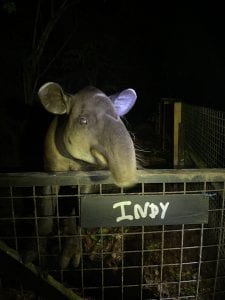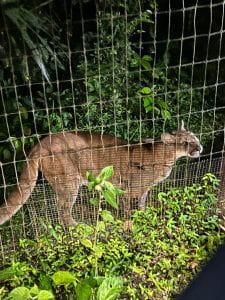Hi Blog,
Today was day 8 in Belize, and our last time in Las Cuevas. We promptly left Las Cuevas at around 7 AM for a 3 hour bus ride to the ATM caves. The bus ride went by soo quickly even though I was not asleep at all — I was listening to music and enjoying the scenery. We had breakfast in the car that Angie had packed for us. I missed hot sauce, but nevertheless, I devoured it.
Once we got to the ATM caves, we changed into our dive booties and began our 30 minute hike to the cave entrance. On our way, we had to cross three rivers. During the first river crossing, I not only slipped with the tour guides remarking “first one down,” but also gained a little tick buddy. I only noticed it there after Noelle had pointed out that there was something on my leg…. This was my first tick bite ever! We also had to pack socks for the dry chamber.
Once we got into the actual cave, the experience was surreal. We started out by a short swim to get past the cave entrance. I was wearing a light weatherproof jacket, and after the first river crossing, my socks were surprisingly dry, so I offered to put Lily and Ian’s socks in my pocket, but unfortunately…. they all got soaking wet during the swim to the cave entrance. We saw cute swarms of minnow-looking fish at the entrance though! After that, the water was usually only up to my knees or my torso.
We saw so many geologic formations, and it was astonishing to imagine that the very path we were adventuring through in the caves were where the Mayan people functioned. Along the way, we saw bats, a river catfish, and a spider. We had to maneuver through many slippery areas and some risky climbs, but all of us successfully made it to the dry chamber, where we then switched out of our dive booties to our (wet) socks.
In the dry chamber, we saw multiple human remains, such as 3 decapitated skulls of human sacrifices, a child’s mandible, and a calcified full human skeleton. It was also super interesting to see the countless Maya artifacts, such as the vessels and ceramics. Most of them were smashed, which apparently was to release the soul of each object after its use was completed. Throughout the entire caving, I was continuously astonished by how I am walking through an integral part of Maya culture, as caves served as a medium between the natural and supernatural worlds.
After the caving, we had lunch provided, which we all absolutely demolished. We then drove an hour to the Tropical Education Center and the Belize Zoo. The night tour of the Belize Zoo was so fun, as I got to see so many animals of my taxa (mammals) that I did not get to witness in the rainforest. We saw many species such and the neotropical river otter, jaguar, margay, kinkajou, tapir, puma, ocelot, and the Mexican hairy porcupine.
All of the animals we saw today were nocturnal species, so we did not get to see much (if any) diurnal species, but regardless, it was so cool to see SOO many mammals!
To begin with, the neotropical river otter we saw was floating around in the waters of its enclosure, and immediately jumped out of the water as soon as it saw the treat that the zookeeper had in hand for it. In fact, the otter also started making squealing noises in excitement!
We also saw two jaguars, which many of my classmates were most excited for. The first jaguar, a female, looked almost AI-generated, and I could not believe I was seeing a jaguar with my own eyes. The female jaguar was just behind the fence of the enclosure, staring at us (and the meat the zookeeper was holding). The zookeeper explained that this jaguar was confiscated from a tourist attraction where the jaguar was kept in very suboptimal conditions.
The second jaguar that we saw was a male one, and he had one of his eyes missing, which the zookeeper explained was due to enucleation (eye-removal) for glaucoma. This jaguar was also standing near the fence in plain sight. It was mainly still for the most part, except when the zookeeper fed him a treat.
It was then fascinating to think about how ~300 jaguars casually roam in the Chiquibul forest. They were most likely in close proximity to us during our hikes, just out of plain sight, especially since we actually were able to smell the distinct odor of cat urine at certain times.
We then moved on to the enclosure of margays. I had a really difficult time spotting them, even though people were pointing directly at it. After 3 minutes or so, I was finally able to see one. It was sitting in the corner of its habitat structure grooming itself. It was super adorable to see an almost super-miniature version of a jaguar, since margays are also spotted, only with the size of a household cat.
We then saw the kinkajou and mexican hairy porcupines. These creatures were interesting to see, as they both have prehensile tails, with allows them to use their tail almost as a fifth limb. The kinkajou was grabbing on to the branch, and got closer as the zookeeper fed him a banana. Likewise, the mexican hairy porcupine was also standing on a branch but did not react much.
An especially exciting portion of this tour was seeing the Baird’s Tapirs — the national mammal of Belize! Although I knew their approximate sizes beforehand, I was still astonished to see their quite immense size with my own eyes. We got to feed the tapirs with the treat that the zookeeper provided for us, and I was intrigued by how the tapirs looked like horses as they chewed.
It was super inspirational to learn about the founding story of the Belize Zoo by Ms. Sharon Matola and also how the Belize Zoo’s primary focus is on the well-being of animals since most of the intake is not only native animals but also from rescued, orphaned, injured, or abandoned backgrounds. I really thought it was meaningful to see how by seeing all of these animals in captivity, people, especially Belizean locals, were able to appreciate their natural heritage including the animals. Before, I think I viewed zoos in a subtly negative light, but after going to the Belize Zoo, I can now appreciate the impact on conservations that zoos can have. Of course, the state of animal welfare would depend per zoo, but from what I could observe, the Belize zoo appeared to be doing a really good job.

Tomorrow, we will eat breakfast at 8 AM then head over to Glover’s Reef on a 3(?) hour boat ride, which is presumably stunningly beautiful, so I am very excited for that. Well, I will see you guys tomorrow!





